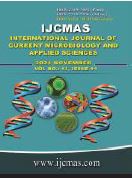


 National Academy of Agricultural Sciences (NAAS)
National Academy of Agricultural Sciences (NAAS)

|
PRINT ISSN : 2319-7692
Online ISSN : 2319-7706 Issues : 12 per year Publisher : Excellent Publishers Email : editorijcmas@gmail.com / submit@ijcmas.com Editor-in-chief: Dr.M.Prakash Index Copernicus ICV 2018: 95.39 NAAS RATING 2020: 5.38 |
The antibacterial investigation of different extracts (Ethanol, propanol, DMSO and di Ethel either) was carried on different species of bacteria including Gram positive bacteria (Staphylococcus aureus, Bacillus cereus and Streptococcus pneumoniae) and Gram negative bacteria: (Escherichia coli, Pseudomonas aeruginosa, Agnobacteriumsp, and Erwinia carotovora).This study was carried out on leafs, stems and seeds of Laurus azorica and Avena sterilis plants, which growing at Al –Gabal Al –Akhder region, Libya.).The results recorded that, there are variations for antibacterial activities, also the results showed different effects on the selected microbial species which selected in this study, where some of extracts gave inhibition zones compared with those which no gave the effect on the studied bacteria. The results recorded different effects of the solvents extracts depending on the polarities and bacteria species. Also the anti-biotic sensitive studies of the plant extracts showed effects on the selected anti-biotic in this study.
Abu-Rabia, A. (2015) ‘Key plants in fighting cancer in the Middle East’, Chinese Medicine. Scientific Research Publishing, 6, p. 124. http://dx.doi.org/10.4236/cm.2015.62014
Ahmed. A, Hussain, Al-Amiery, Ali. A, AL-Temimi, Raghda. I, Wagaa and Abood. H (2010) A study of the biological activities of Avena sativa extracts. African Journal of Pure and Applied Chemistry 4. 31-34. https://doi.org/10.5897/AJPAC.9000004
Akinpelu Da, Aiyegoro OA, Okoh AI (2008) In vitro antibacterial and phytochemical properties of crude extract of stem bark of Afzelia africana (Smith). Afr J Biotech 7(20): 3662-3667
Al-Amiery, A. A. H. (2010) ‘A study of the biological activities of Avena sativa extracts’, 4(March), pp. 31–34.
Altemimi, A., Lakhssassi, N., Baharlouei, A., Watson, D. G., & Lightfoot, D. A. (2017). Phytochemicals: Extraction, isolation, and identification of bioactive compounds from plant extracts. Plants, 6(4), 42. http://dx.doi.org/10.3390/plants6040042
Boczkowska, M., Podyma, W. and ?api?ski, B. (2016) ‘Oat’, in Genetic and Genomic Resources for Grain Cereals Improvement. Elsevier, pp. 159–225.
Boussoussa, H., Hamia, C., Djeridane, A., Boudjeniba, M., et al., (2014) ‘Effect of different solvent polarity on extraction of phenolic compounds from Algerian Rhanterium adpressum flowers and their Antimicrobial and antioxidant activities’, Current Chemical Biology. Bentham Science Publishers, 8(1), pp. 43–50 http://dx.doi.org/10.2174/221279680801141112095950
Cosimir. M. N.; Soum, M. H.; Boivin, P.; Berset, C. (2008): Antioxidant activity of barley and malt: Relationship with phenolic content. LWT Food Sci. Technol. 29, 238–244.
Derwich, E; Benziane, Z. and Boukir, A. (2009): ’’Chemical composition and antibacterial activity of leaves essential oil of Laurus nobilis from Morocco‘‘, Aust. J. Basic Appl. Sci., 3,3818-3824.
El, S. N. et al., (2014) ‘Antioxidant and antimicrobial activities of essential oils extracted from Laurus nobilis L. leaves by using solvent-free microwave and Hydrodistillation’, Food and Nutrition Sciences. Scientific Research Publishing, 2014. http://dx.doi.org/10.4236/fns.2014.52013
Goudji, M. B., Segni, L., Salah E. B., Souad, Z. and Djamila, H. (2015). Study of the chemical composition, antibacterial and antioxidant activities of the essential oil extracted from the leaves of Algerian Laurus nobilis Lauraceae. Coden : Journal of Chemical and Pharmaceutical Research, 2015, 7(1):379-385
Hasan, H. M. Idres., El-Mehdawy, M. F. and Eman K. Saad. (2014). Amino acids contents of leaves and stems for two types of herbal plants (Marjoram and Hybrid tea rose) at AL-Gabal AL-Akhder region. Der PharmaChemica, 2014, 6(6):442-447. Available online at www.derpharmachemica.com
Hasan, H. M., Ibrahim H. Habib1., Mariam. H. Gonaid. and Mojahidul Islam. (2011). Comparative phytochemical and antimicrobial investigation of some plants growing in Al Jabal Al-Akhdar. J. Nat. Prod. Plant Resour., 2011, 1 (1):15-23.
Hussein, N. H., Marzoog, T. R., Al-Niaame, A. E. (2019): The antibacterial, antiheamolytic, and antioxidant activities of Laurus nobilis and Alhagi maurorum native to Iraq. – Baghdad Science Journal 16(3): 707-712.
Iwu. M. M, Duncan. C. O, Okunji, 1999: New antimicrobials of plant origin. In J. Janick (ed). Prospective on new crops and new uses. ASHS press, Alexandria, V.A. pp: 457-462.
Marmouzi, I., El Mostafa, K., Nezha, S., Bouchra M., Mourad, K., Azlarab M., Mounya, B., Layachi, C., Khalid, E. and El Abbes, F. (2017). In Vitro and In Vivo Antioxidant and Anti-Hyperglycemic Activities of Moroccan Oat Cultivars. Antioxidants (Basel)6;6(4):102. https://doi.org/10.3390/antiox6040102
Mukherjee, P. Balasubramanian, R. Saha, K. B and Pal, M, J. (1995) ‘Antibacterial efficiency of Nelumbo nucifera (Nymphaeaceae) rhizomes extract.32, 274- 276.
NCCLS - (2001): “National Committee for Clinical Laboratory Standards Performance Standards for antimicrobial Susceptibility testing Eleventh information Supplement”, Nccls Document, M100-S11. Nccls, Wayne, Pennsylvania 2001.
Ramos, C. L. (2013). Evaluation of stress tolerance and fermentative behavior of indigenous Saccharomyces cerevisiae. Braz J Microbiol44(3):935-44 https://doi.org/10.1590/S1517-83822013005000051
Zeyaullah, M. Z., Ahmed, R., Nassem, A. Isalm, B., Hamad. M. Hasan., F. F. Benkhayal., Moshahid, A. Rizvi. and Arif. A. (2009). Catechol biodegraiation by Psedumonas Strain: a critical analysis. Int.j.chem.sci. No(7): 3: 2211 – 2221 |
 |
 |
 |
 |